
How much have President Obama and Congress cut federal deficits so far?
"Over the last few years, both parties have worked together to reduce the deficit by more than $2.5 trillion," Obama said in his State of the Union address Tuesday.
What did he mean? That $2.5 trillion is the amount of deficit reduction over a decade compared to where things stood in August 2010, according to calculations from the bipartisan Committee for a Responsible Federal Budget.
Why August 2010? That was the launching point used by the president's fiscal commission chaired by Erskine Bowles and Alan Simpson.
Where does the $2.5 trillion come from? Several sources: savings from the 2011 Budget Control Act, lower spending levels enacted in temporary government funding resolutions since 2010, and the fiscal cliff deal passed at the start of this year.
In fact, the latest savings estimate is actually closer to $2.7 trillion, according to Marc Goldwein, CRFB's senior policy director.
Of that amount, $1.57 trillion comes from spending cuts, $690 billion from increased tax revenue and $430 billion from interest savings.
But how much deficit reduction has been achieved can be measured differently. For example, the savings look much smaller if you choose an earlier starting date.
That's in part because August 2010 marked a high point for federal spending on "discretionary" programs. If, say, August 2007 is the comparison point, the savings amount to only about $450 billion, according to CRFB's estimates.
The summer of 2007, of course, predated the steep drop in revenue and the more than $1 trillion in stimulus injected into the economy as a result of the financial crisis and the recession.
How much should deficits be reduced now? Obama said again on Tuesday that the goal is $4 trillion over the next decade. So after counting the approximately $2.5 trillion in savings, he said, "we are more than halfway towards [that] goal."
In other words, Washington needs to come up with another $1.5 trillion.
What could another $1.5 trillion in deficit reduction accomplish? It could stabilize the debt held by the public as a share of the economy. Under this scenario, within the next decade the debt would level out -- at least for awhile -- at 73% of GDP, which is where it was in 2012.
Related: Biggest budget busters

Some independent deficit hawks say 73% is still too high.
"It would leave no margin for error, would result in slower economic growth, would leave little fiscal flexibility, and would have little chance of stabilizing the debt beyond the ten-year window," CRFB noted in a recent report.
In other words, one more recession or war could put a strain on federal coffers and push the debt past 73% very quickly.
Another reason: Even if nothing goes wrong, the debt is expected to rise again as a percentage of the economy soon after 2023.
To help make sure that doesn't happen, hawks would aim to stabilize debt at 70% or less. And that would require at least $2.4 trillion in deficit reduction over the next decade, CRFB estimates.
On the other hand, Josh Gordon, policy director for the nonpartisan Concord Coalition, notes that adhering to a strict 10-year deficit reduction goal is less important than the policies put in place to achieve it -- a point that CRFB also makes.
"One could easily envision a deficit-reduction package that falls short of debt stabilization ... but is still more fiscally responsible than a package that would lower the debt-to-GDP ratio [within 10 years]," Gordon wrote in a recent blog post.
Such a plan might include ways to control health spending growth, adjust Medicare and Social Security for the swell of new retirees over the next two decades, boost economic growth and raise more revenue through serious tax reform.
Indeed, CRFB notes, "a deficit reduction package should be judged on theses parameters, rather than solely what debt target it achieves."


